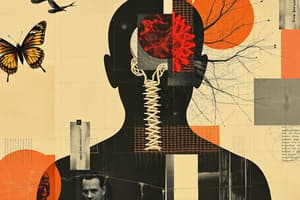Podcast
Questions and Answers
What are the four processes involved in nociceptive pain?
What are the four processes involved in nociceptive pain?
- Identification, modulation, alteration, and transmission
- Reactivity, perception, transmission, and generation
- Transmission, interpretation, modulation, and generation
- Transduction, transmission, perception, and modulation (correct)
What triggers nociceptors to send messages to the nervous system?
What triggers nociceptors to send messages to the nervous system?
- Chemical signals from healthy tissues
- Changes in neurotransmitter levels in the brain
- Stimuli following tissue damage such as cuts or burns (correct)
- Neuropathic impulses from the central nervous system
Which process is primarily responsible for changes in pain perception due to nerve ending damage?
Which process is primarily responsible for changes in pain perception due to nerve ending damage?
- Peripheral sensitization
- Neuroplasticity (correct)
- Peripheral desensitization
- Central modulation
What central nervous system changes contribute to neuropathic pain?
What central nervous system changes contribute to neuropathic pain?
What is a common factor that leads to neuropathic pain?
What is a common factor that leads to neuropathic pain?
Flashcards
Nociceptive pain
Nociceptive pain
Pain caused by the activation of nociceptors in response to tissue damage or harmful stimuli.
Neuropathic pain
Neuropathic pain
Pain caused by damage or dysfunction of the nervous system, not just tissue damage.
Peripheral sensitization
Peripheral sensitization
Increased responsiveness of peripheral nerve fibers to painful and non-painful stimuli.
Nociceptors
Nociceptors
Specialized nerve endings that detect painful stimuli.
Signup and view all the flashcards
Neuroplasticity
Neuroplasticity
Changes in the structure and function of the nervous system in response to injury or stimulation.
Signup and view all the flashcardsStudy Notes
Nociceptive Pain
- Nociceptive pain is a process involving the transduction, transmission, perception, and modulation of impulses from nociceptors.
- Nociceptors are activated by stimuli following tissue damage (cuts, burns, tumors, chemicals).
- These stimuli trigger the nociceptors to send signals to the nervous system.
Neuropathic Pain
- Neuropathic pain originates from changes in the peripheral or central nervous system.
- Peripheral nervous system changes contributing to neuropathic pain include peripheral sensitization, changes in ion channels, and neuroplasticity.
- Neuroplasticity describes abnormal reorganization of nerve endings after damage.
- Central nervous system changes involve increased excitability of central neurons, altered neurotransmitter release and binding, and nerve reorganization following injury.
- These changes alter and increase pain sensations.
Studying That Suits You
Use AI to generate personalized quizzes and flashcards to suit your learning preferences.




